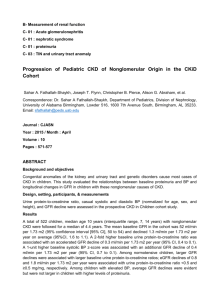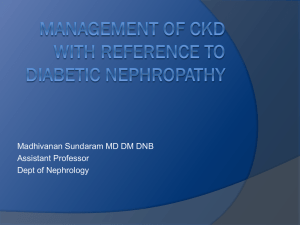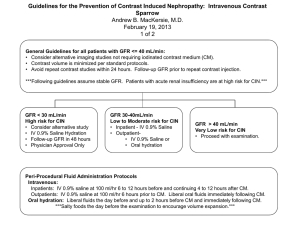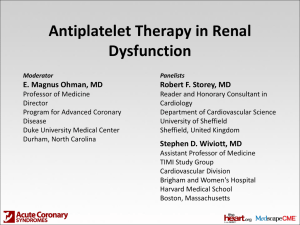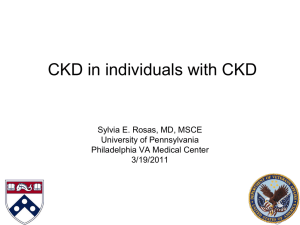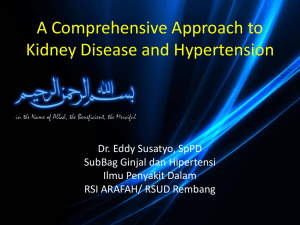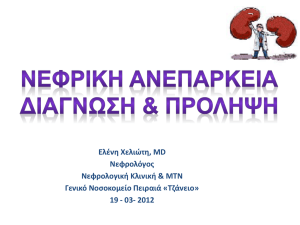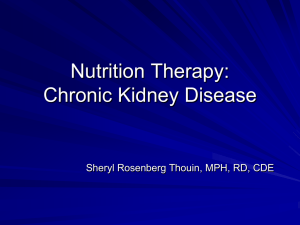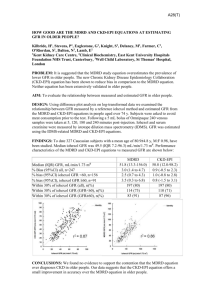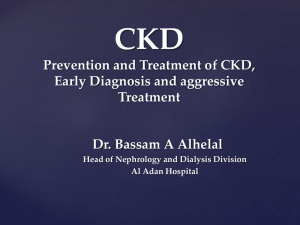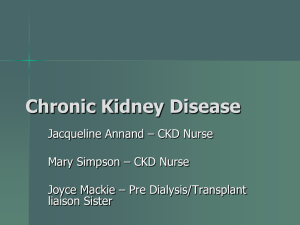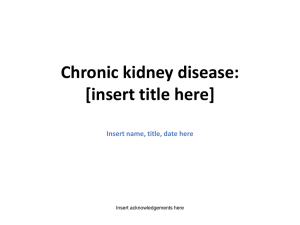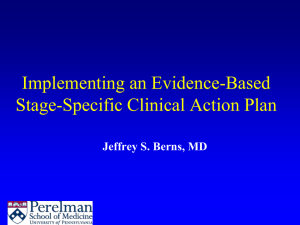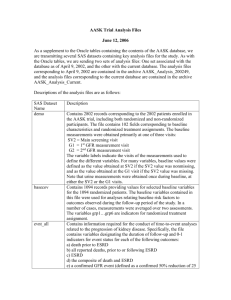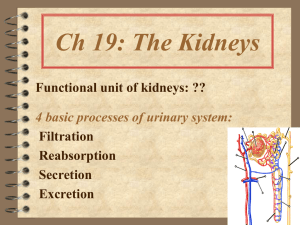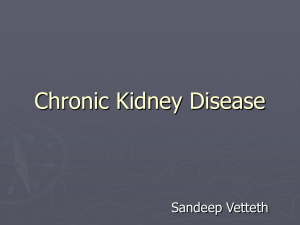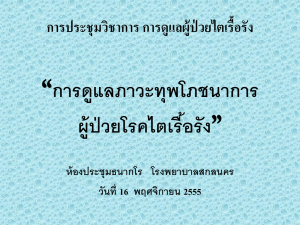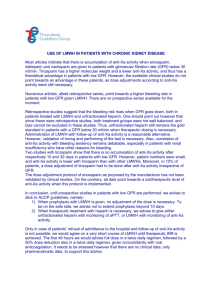PCP Role in Prevention and Risk Management
advertisement
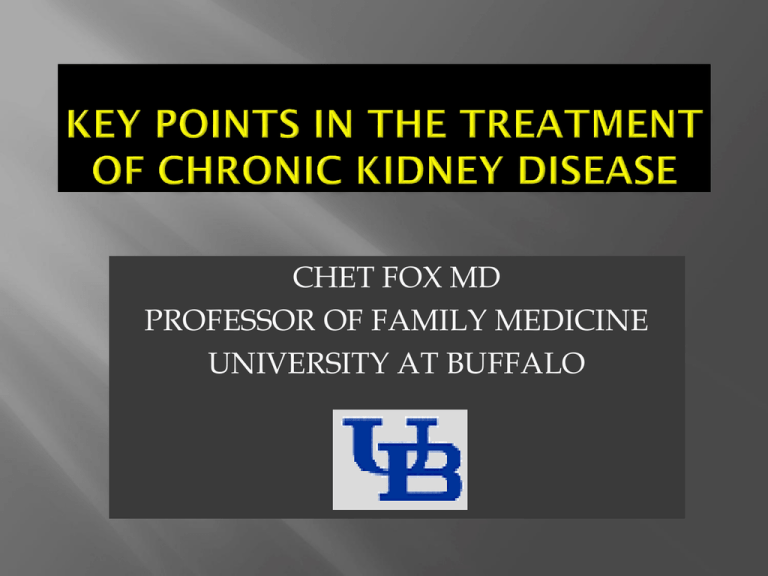
CHET FOX MD PROFESSOR OF FAMILY MEDICINE UNIVERSITY AT BUFFALO CKD affects 26 million Americans Prevalence is 11-13% It consumes 28% of the Medicare Budget This was 6.9% in 1993 Costs for 2013 were $42 Billion dollars DM+ CKD increases mortality rate 6 fold CKD disproportionally affects African Americans and Hispanics http://usrds.org Hypertension Diabetes CAD Family History CKD African American Elderly Morbid Obesity eGFR ACR Albumin/ Creatinine ratio •A GFR loss of > 1 mL/min/year beginning at age 25 can result in end-stage renal disease within a normal lifespan. Lee A Hebert et al. Kidney International (2001) 59, 1211–1226 HTN AND DM ARE THE LEADING CAUSE OF CKD HYPERTENSION CVD DIABETES CKD Two New England Journal publications indicate that Cardiovascular survival is directly related to a patient’s kidney function!! NS Anavekar, et al. N Engl J Med 2004;351:1285-95 AS Go, et al. N Engl J Med 2004;351:1295-305 HYPERTENSION BONE DISEASE CKD ANEMIA DIABETES PROTEINURIA SAVE YOUR KIDNEYS AND SAVE YOUR HEART Diagnosis Recognition of Complications Medication Safety Treatment Preparation for Vascular Access When to Refer GD is a 63 year old African American female with poorly controlled HTN, DM, increased lipids, obesity, GERD , gout, and sleep apnea. She has not had an MI (yet) She smokes ½ PPD Meds include Amlodipine 10 qd, HCTZ 25 qd, Clonidine 0.3 bid, Atorvastatin 10, Metoprolol 100 bid, Insulin glargine 30 at HS, Metformin 1000 po bid, Allopurinol 300 qd, L, Omeparazole 20 qd, and CPAP at 12 cm (Note: she is not on an ACE) BP is 150/86; Labs: HbA1C is 10.4; Hb is 9.5, HDL is 35, LDL is 115, triglycerides are 295; Ca is 9.8; Microalbumin/creatinine ratio is 54.5; Creatinine is 1.7: GFR = 39 GD has stage 3 CKD and most of it’s complications. What should we do for this patient? Microalbumin/Creatinine >30 GFR < 60 GD has Stage 3B;A2 CKD This puts her at moderately high risk HYPERTENSION ANEMIA KIDNEY DZ DIABETES PROTEINURIA HYPERLIPIDEMIA BONE LOSS There are meds that are dangerous to her: We stop them or modify dose GD is taking OTC NSAIDS for her back pain We stop this and all NSAIDS and Cox-2 Metformin can cause lactic acidosis. We stop if GFR < 30 We reduce her Allopurinol We avoid Bisphosphonates ACE is added to reduce proteinuria and delay CKD progression. GFR decreases to 32 but stays there. Creat is 2.1 K+ is good at 4.0 We leave her on the ACE Her BP goes down to 130/70 We stop her clonidine as it is no longer need She starts a diet and exercise program We encourage patient centered goal setting (Motivational Interviewing) We intensify her insulin regimen We add Sitagliptin, liraglutide, or glypizide to her insulin Her HbA1C drops to 6.8 over 6 months We increase her statin to Atorvastatin 40 mg qd We start ASA 81 mg qd We give her the ACS quit smoking line number We add Niaspan 500 qd or Omega 3’s One gram bid to raise HDL and decrease Triglycerides She quits smoking, Her HDL is now 43, LDL 68 and Triglycerides 130 Colonoscopy is normal MCV is nl at 85 Fe is 50; TIBC is 200 for a saturation of 25% We start Erythropoieitin 20,000 units q 2 weeks We start oral iron √CBC ,Fe/TIBC monthly. We hold EPO if Hb > 12.0 Hb rises to 11.5 and she feels much better Transferrin saturations stay normal at above 20% We √ Ca++; PO4=; and PTH and 25 OH Vit D levels Ca++ is 9.8 (nl) PO4= is 3.1 (nl) PTH is 60 (nl) Vit D is 7 (low) We start her Vit D 50,000 units once per month or 1,000-2,000 units daily We follow these labs yearly and refer if PTH > 100 or PO4= rises above 4.5 We remember “Fistulas first and Catheters Kill” We tell her to to use the back of her hand for blood draws We refuse to allow any PICC lines to be put in when GFR < 45. We refer her to nephrology when GFR < 30 If the GFR <20; we refer for transplant evaluation even before she needs dialysis She does not have a heart attack She lost 30 pounds Her kidney disease stabilizes She feels better and has more energy We delay the need for dialysis She does not get a hip fracture If she does progress, she will be referred early Use GFR, Urine Microalbumin to diagnose CKD If GFR < 60 or Microalbumin/creat > 30 start ACE (If cough on ACE, start ARB) Avoid NSAIDS Refer to Nephrology for GFR < 30 Refer for Transplant evaluation for GFR < 20 Promote smoking cessation Keep BP < 140/90 Keep HbA1C < 7.0 Keep LDL < 100 Avoid PICC lines for GFR < 45 Check Calcium, Phosphorous, PTH, and Vit D yearly Check Hemoglobin yearly If iron is normal, start erythropoietin if Hb< 10 or refer to Nephrology Refer to Nephrology for Phosphorous >4.5 or PTH > 100 GFR< 30 Rapidly deteriorating kidney function Marked proteinuria Difficult-to-control hypertension PTH > 100 or Phosphate > 4.5 GFR < 20; Refer for Transplant evaluation eGFR What to do >60 and microalbumin< 30 Yearly surveillance with GFR (for hypertensive patients) and both GFR and microalbumin (for diabetic patients) >60 and microalbumin > 30 ACE or ARB >45 and < 60* >30 and < 45 ACE or ARB Discontinue NSAIDS ? off Metformin** Check hemoglobin Check Calcium, Phosphorous, PTH and Vitamin D yearly The above plus Stop metformin** No PICC lines All blood draws from dominant arm (Save an Arm) < 30 Refer to Nephrologist < 20 Refer for transplant evaluation * Need 2 consecutive GFR <60 at least 3 months apart to diagnose CKD. If the patient does not have risk factors of hypertension, diabetes, family history or coronary disease, this might be a false positive test. *Treat hypertension, diabetes, and hyperlipidemia the same way you would treat a diabetic patient. **Metformin does not cause progression of CKD, but it increases the risk of lactic acidosis.
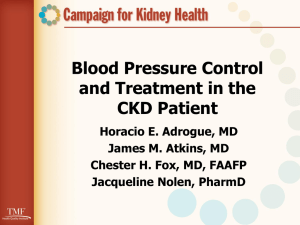
![Risk Adjustment Factor [RAF]](http://s2.studylib.net/store/data/005748329_1-97f04b2983127ae4930cafa389444167-300x300.png)
